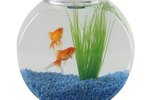
Reef aquariums replicate the saltwater environment of tropical fish as closely as possible in your home. Coral and other invertebrates live alongside your fish, sharing the same aquatic environment -- including any water imbalances that occur. Ammonia can be deadly to all creatures inhabiting your tank, so check for it often and watch for signs of ammonia poisoning.
Ammonia
Ammonia appears in your aquarium a few ways, but typically it's from decomposing plant food and fish waste. Healthy bacteria present in your living reef and filtration system should break down the ammonia efficiently. If the tank environment changes, such as when you add too many fish to the tank, the bacteria might no longer be effective. Testing for ammonia every couple of days helps you recognize a problem before it starts. When a test kit registers any amount of ammonia, even 0.1 to 0.5 ppm, act quickly to save your fish.
Damage
Ammonia works quickly to damage one of the most important fish organs: the gills. Because the gills touch the ammonia in the water, they become affected almost immediately. Blood vessels burst and the membranes thicken, causing gills to look red and swollen. Because ammonia often is released through the gills, damaged gill tissue means an ammonia buildup inside the fish, causing organ failure. Corals and other invertebrates also are affected, usually through damage to their exterior cells that come in contact with the toxic water.
Symptoms
Signs of ammonia poisoning come on fast, usually with fish gasping for air and floating near the surface. They might on the other hand be lethargic and float near the bottom. Many stop eating, which can increase ammonia levels as uneaten food begins to break down in the tank. The fish might die off in large numbers. Invertebrates might retract tentacles, shrink or die.
Control
When you see signs of ammonia poisoning in your fish, or if an ammonia test shows any level of the chemical, act quickly to save your fish. Although tank supplements exist to help change the water chemistry, one of the fastest ways to reduce ammonia levels is to change some of the water. A 25 percent water change typically is sufficient, but if the water still tests positive the next day, change up to 50 percent to remove as much ammonia as possible.
References
Photo Credits
-
Jochen Sands/Photodisc/Getty Images




